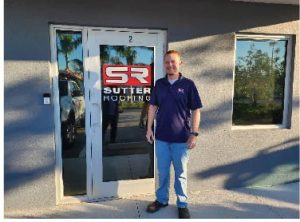— By Hara J. Prager and Tom Coble —
Whose leak is it anyway? HVAC provider or roofer?
Imagine — it is a beautiful spring day; the air is cool and crisp, the sun is bright, with the promise of summer days near. You’re enjoying your first day off after the holiday rush. At least now, with the ice of winter behind you, you won’t be facing water leaks…right? Think again!

Hara Prager, Brinco
On this beautiful 50-degree morning, as you’re enjoying a stroll, you get a panicked call from your manager on duty (MOD) that there is water leaking from the ceiling, and the location will have to close until resolved out of an abundance of caution (of course they’ve already placed a receptacle underneath to catch the water, and cordoned off the area for the safety of anyone remaining onsite).
Not a stellar start to your day off.
You immediately instruct your MOD to contact your tried-and-true roofing partner to investigate ASAP since it couldn’t be the HVAC system — there’s no way the AC could possibly be running at this time of year (so you think!). Your roofing partner is onsite within 4 hours, and surprise surprise, they blame your HVAC units! It is now 2:00pm, and you’re pressing pause on your lunch plans to dispatch a call to your trusted HVAC partner. Your HVAC partner arrives by 5:00pm, by which point you’ve lost an entire day of sales, your boss is annoyed, and you’re now running into overtime hours for your service call, and oh by the way, water is still dripping into your facility!

Tom Coble, Pegnato
The HVAC technician does their due diligence and, surprise surprise, they blame your roof! (We HVAC providers and roofers are known to point fingers at one another.) Now, it is 7:00pm, and you’re back at square one, calling your roofing partner to come and take another look tomorrow morning.
Not a stellar end to your day off, either.
At this point, prior to re-dispatching your roofing vendor, you should be requesting an onsite vendor meet between your roofing and HVAC partner to avoid any further delays in repairs. But first let’s rewind to this morning when you were outside enjoying the weather. Could it be that your first call should’ve been to your HVAC provider?
While every water leak is different and every facility is unique, here are a few ways to predict where your water leak might be coming from, and who to call first (clue: it’s not Ghostbusters).
The first thing to notice is that today is a bright, sunny day with no rain clouds in sight. Despite the temperatures, if you’re finding water leaking into your facility on a cool, dry day, your first thought should be HVAC — though this is not to say that a roof leak isn’t to blame. We’ll go into further detail on possible causes later on.
If we take a trip to upside-down land where instead of enjoying the weather outside, you’re cozied up on the sofa with a good book or watching a Netflix series listening to the torrential downpour when the panicked water leak call comes in, it is a 50-50 as to whether the roof or the HVAC system is the cause.
In this rainy-day scenario, the roofer is called out first. The roofer arrives, and the MOD shows the water intrusion into the facility. The roofer then locates the corresponding area on the roof, and sure enough, they find a void! The technician executes a thorough repair utilizing proper materials, and miraculously, the leak issue is resolved. You breathe a sigh of relief and hit “resume” on that Netflix series. But anyone reading this article knows how infrequently water leaks are repaired as quickly or easily as that.
Often, the roof and structure composition will impact how water travels underneath the membrane. For example, a roof with metal decking can present a challenge when attempting to identify the source of a leak. Water travels the path of least resistance, and on a roof with a sloped metal deck, water can travel quite some distance along its seams. Thus, the source of a leak can be located tens of feet from where the water is intruding inside the facility. To complicate things even further, the same can happen when the source of the leak is HVAC related.
Given that the roof, and the equipment on it, are not consistently in the line of sight, it’s an easy area to forget or ignore. Major issues are frequently not identified until they result in an emergency call. As far as roof maintenance goes, conducting regular roof inspections and drain cleanings are the most effective ways to identify issues before they result in an emergency call. Gaining visibility into an area not typically seen with any regularity can greatly reduce those “911” calls (and ensuing detective missions) on one’s day off by identifying visible defects and recommending proactive repairs, and clearing drains of debris while on the roof can help avoid a far more dangerous problem: a roof collapse.
But let’s return to our day-off-disaster thought experiment. The roofer has come out, looked from underneath as well as upon the roof, yet cannot identify any roof-related leak source. The technician performs a water test and determines that the source is likely HVAC related.
Now, let’s explore the possible reasons why your HVAC equipment could be leaking. Your first thought was that your HVAC system couldn’t be running, because the outside temperature was 50 degrees, and you never switched on the AC. Here’s the real-life scenario that very well could’ve happened: Since your facility happens to have auto-changeover thermostats, your units automatically switched from heating operation to cooling operation. Your units were also installed with outdoor air economizers, which should allow the units to cool the store without bringing on the units’ compressors. Your luck, the outdoor air damper on one of the units failed to open due to a burned out damper actuator. The temperature at the thermostat that controls the unit rose another degree, and the thermostat started calling for second stage cooling. The compressor then kicked on because the economizer was unable to cool the space with your outside air. The compressor is now operating at an outdoor ambient temperature of 50 degrees. Since the unit has an economizer, it lacks the controls that would allow the compressor to operate at such a low outdoor temperature. The compressor is now operating at lower pressures and temperatures than it was designed for — leading to the evaporator (indoor coil) temperature to drop below 32 degrees, and ice begins to form on the coil. Eventually, the entire coil is covered in ice, and the pressure within the coil drops low enough to trip a safety control, shutting down the compressor before it freezes up. On units that are not equipped with this safety control (low pressure switch), the compressor may be destroyed as it attempts to pump refrigerant in its liquid state rather than in its gaseous state. Now that the compressor has shut down, the ice on the coil begins to melt, and since the ice is blocking the unit drain fitting, water begins to leak into the store — and here is where your panicked phone call came in despite the 50-degree weather.
Some additional causes for water leaks in HVAC systems are low airflow due to clogged filters, loose belts and clogged condensate lines. These causes can usually be avoided by a strong strategic plan for HVAC maintenance. Let’s start with air filters; air filters invariably get clogged after a certain number of hours of blower operation. It is less costly to replace filters on a scheduled basis than when clogged filters have reduced airflow to the point where you have a water leak. Scheduled filter replacement is always more cost-effective than demand filter replacement, as demand replacement typically requires two visits by a technician: the first for diagnosis, and the second to replace the filters after sizes and quantities have been determined. Next, we’ll look at drive belts; drive belts are the link between the blower motor and the blower wheel in an air conditioning system, typically made from reinforced neoprene. The average lifespan of a drive belt in a typical retail store is a little over a year. If a belt is replaced annually on a preventive maintenance visit, you can anticipate an average cost of $50 included in the PM (preventive maintenance) cost. However, if that belt fails, or becomes loose due to wear and tear, you’re looking at a repair cost of $250 during normal business hours, and the possibility of water damage. As for clogged condensate lines, and the burned out damper actuator in your day-off-disaster scenario, this is where the importance of your cooling start-up comes in. Cooling season inspections are justified for almost all HVAC systems. In short, clean the condensate pan now, avoid condensate leaks later; catch a failing component now, avoid days of downtime later; discover a refrigerant leak on a cooling inspection, avoid a water leak due to low charge with two days of down time for repair later. Have a strong line of communication with your HVAC vendor partner to develop a preventive maintenance/repair plan that best suits the needs of your chain and your equipment — and avoid day-off-disaster scenarios.
We’d like to conclude our beautiful spring day-off-disaster by returning to the roof for a vendor meet between your HVAC and roofing providers. While diagnosing the water leak and laying blame at the other’s feet, your excellent HVAC and roofing providers both concluded that they could coexist peacefully, and avoid water leaks, if the following was considered by each vendor while onsite.

Tony Heider, Sutter Roofing
We consulted Tony Heider, service superintendent of Sutter Roofing in Fort Myers, Florida, as he has a rather unique background. In addition to being an elite roof technician, his original entry into the trades after serving our country in the Navy was serving several years as an HVAC technician. He offered his comprehensive perspective on best practices when conducting any type of maintenance on rooftops, as well as how to achieve a more harmonious relationship between roofers and HVAC technicians.
First, in Tony’s experience as both an HVAC and roofing technician, it typically takes two separate visits by the roofer and HVAC provider — each suggesting that the problem is related to the other trade — before a vendor meet is called. To avoid further incurred cost, and time delays, Tony recommends calling the meeting after each trade’s initial visit.
Furthermore, Tony offers up these rules of thumb for each tradesperson to follow on their individual repair visit:
ROOFERS:
- If it requires a screwdriver, do not touch it;
- Curiosity (messing with wires) killed the roofer;
- If you disconnect a condensate line, reconnect it when you leave;
- Never turn a P-trap upside down.
HVAC TECHNICIANS:
- Do not put out cigarette butts on the roof (even better, don’t smoke on a roof);
- Be cautious when moving access panels — drops cause holes;
- Avoid kicking the roof flashing with the toes of your boots;
- Do not leave any screws or debris on the roof.
For our purposes, it really doesn’t matter whether the leak was roof or HVAC related. The key takeaway from our day-off-disaster is that having proactive maintenance and repair programs in place, as well as active lines of communication between the facility/property manager, the roofer and the HVAC provider are extremely important. Regular visits, preventive maintenance and a collaborative relationship between all parties can minimize emergency leaks, reduce the stress of onsite management and continue the ideal customer experience (with the added bonus that you get to enjoy your PTO!).
— Hara J. Prager, Esq. is an associate director with Brinco Mechanical Management Services Inc. (www.brinco.com), providing the highest quality of national commercial HVAC and refrigeration management services. She can be reached at [email protected]. Tom Coble is executive vice president, Ecosystem, with Pegnato Roof Intelligence Network (www.pegnato.com), a digital roof management platform that connects national, multi-site companies with high-quality local contractors, utilizing data analytics to improve roof performance and achieve the lowest total cost of ownership across clients’ roof portfolios. You may reach him at [email protected].

